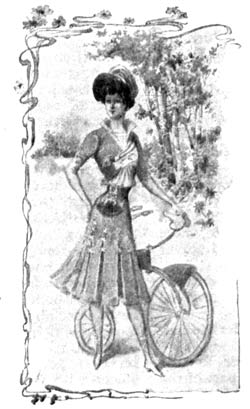Predicting How Women of the Future Would, and Would Not, Dress

The 1900s seem to have been a good decade for predicting. We’ve already reported on two Post authors, Otis Mason and John Elfreth Watkins, who had better-than-average forecasting skills. This week, we introduce another: Octave Uzanne, who showed remarkable foresight in his 1901 Post article “What Women Will Wear in the Twentieth Century.”
In this fashion forecast, Uzanne anticipated the fundamental change in women’s wardrobes that would reflect a changing status. When the young girls of 1901 reached adulthood, he said, they would live quite differently from their mothers. In general, they would be less frivolous. Unlike their mothers, they would be less willing to spend long hours dressing themselves in ornate, impractical clothing: “hours which might be filled with work or pleasure more interesting and no doubt more healthful.”
Even though women wouldn’t be able to vote for another 19 years, Uzanne could see women already taking a more active role in their world.

And fashion would reflect the modern woman’s new interest in mobility and practicality, and give her a sense “of her force, of her rights, of the less subordinate part which might fall to her in the future.”
Her wardrobe would be built around an active life. Unlike the stay-at-home women of the 1900s, the future woman would be a “traveler and student, a lover of sport, of bicycling, and of motor-driving, in mind more independent than ever.” It would be hard to see in the modern woman the sickly and capricious child she had been in previous generations.
Men, he predicted, would first judge her new, comfortable clothing to be immodest, but they eventually would have to accept it because women were through with the floor-length skirt, the veil, and the corset. “No more tight-laced busts and swelling necks; no more whalebone compression and misshapen chests—instead, free bodies.” In making these predictions, he was not simply stating the obvious. Corsets remained in general use for the next two decades, and girdles until the 1960s.

To appreciate Uzanne’s predictive skills, you need to move forward 63 years, when decorator Evelyn Jablow tried her hand at forecasting in “Designs On Your Future.” Having just visited the Milan Triennale exhibit of 1964, she gave her predictions of women’s fashions in the 21st century.
Future women, as she imagined then, would wear just one outfit: a one-size-fits-all top made of stretch material and tights. The entire wardrobe, just “three or four pieces of clothing,” would fit into a cylinder the size of a golf bag. Also, women would wear only boots and slippers, and no earrings or bracelets.

As for men, they would “abandon tie, shirt, and trousers” to wear a “one-piece stretch moon suit” when traveling (presumably through outer space) and, at home, “long tights and a short toga, reminiscent of the free-swinging styles of the Roman charioteer.”
It must have seemed reasonable in 1964, because William Hanna and Joseph Barbera had pretty much the same idea of fashion in 1962 when they created The Jetsons.